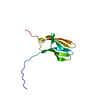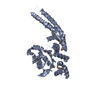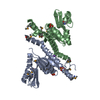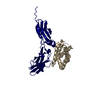+ Open data
Open data
- Basic information
Basic information
| Entry | Database: PDB / ID: 1hcf | ||||||
|---|---|---|---|---|---|---|---|
| Title | Crystal structure of TrkB-d5 bound to neurotrophin-4/5 | ||||||
 Components Components |
| ||||||
 Keywords Keywords | TRANSFERASE/HORMONE / COMPLEX(TRANSFERASE-GROWTH FACTOR) / NEUROTROPHIN-4/5 / TRKB RECEPTOR / NGF-BETA SUPERFAMILY / IMMUNOGLOBULIN DOMAIN / TRANSFERASE-HORMONE complex | ||||||
| Function / homology |  Function and homology information Function and homology informationtaste bud development / sensory organ boundary specification / ganglion mother cell fate determination / brain-derived neurotrophic factor binding / brain-derived neurotrophic factor receptor activity / BDNF activates NTRK2 (TRKB) signaling / NTF4 activates NTRK2 (TRKB) signaling / NTF3 activates NTRK2 (TRKB) signaling / brain-derived neurotrophic factor receptor signaling pathway / Activated NTRK2 signals through PLCG1 ...taste bud development / sensory organ boundary specification / ganglion mother cell fate determination / brain-derived neurotrophic factor binding / brain-derived neurotrophic factor receptor activity / BDNF activates NTRK2 (TRKB) signaling / NTF4 activates NTRK2 (TRKB) signaling / NTF3 activates NTRK2 (TRKB) signaling / brain-derived neurotrophic factor receptor signaling pathway / Activated NTRK2 signals through PLCG1 / retinal rod cell development / peripheral nervous system neuron development / nerve growth factor receptor binding / ameloblast differentiation / trans-synaptic signaling by BDNF, modulating synaptic transmission / mechanoreceptor differentiation / neurotrophin binding / Activated NTRK2 signals through CDK5 / nerve growth factor signaling pathway / NTRK2 activates RAC1 / nerve development / Activated NTRK2 signals through FYN / NGF-independant TRKA activation / Activated NTRK2 signals through PI3K / myelination in peripheral nervous system / feeding behavior / positive regulation of axonogenesis / neuronal action potential propagation / glutamate secretion / innervation / positive regulation of synapse assembly / regulation of GTPase activity / central nervous system neuron development / negative regulation of amyloid-beta formation / oligodendrocyte differentiation / negative regulation of anoikis / Activated NTRK2 signals through RAS / epidermis development / long-term memory / Activated NTRK2 signals through FRS2 and FRS3 / vasculogenesis / neuron projection morphogenesis / cellular response to brain-derived neurotrophic factor stimulus / axon terminus / cell surface receptor protein tyrosine kinase signaling pathway / adult locomotory behavior / learning / cellular response to amino acid stimulus / growth factor activity / positive regulation of neuron projection development / circadian rhythm / receptor protein-tyrosine kinase / cerebral cortex development / modulation of chemical synaptic transmission / long-term synaptic potentiation / neuron migration / neuron differentiation / terminal bouton / Constitutive Signaling by Aberrant PI3K in Cancer / synaptic vesicle / PIP3 activates AKT signaling / protein autophosphorylation / PI5P, PP2A and IER3 Regulate PI3K/AKT Signaling / protease binding / early endosome membrane / dendritic spine / negative regulation of neuron apoptotic process / early endosome / positive regulation of phosphatidylinositol 3-kinase/protein kinase B signal transduction / receptor complex / positive regulation of MAPK cascade / postsynaptic density / axon / positive regulation of cell population proliferation / dendrite / positive regulation of gene expression / perinuclear region of cytoplasm / protein homodimerization activity / extracellular space / extracellular region / ATP binding / plasma membrane / cytosol Similarity search - Function | ||||||
| Biological species |  HOMO SAPIENS (human) HOMO SAPIENS (human) | ||||||
| Method |  X-RAY DIFFRACTION / X-RAY DIFFRACTION /  SYNCHROTRON / SYNCHROTRON /  MOLECULAR REPLACEMENT / Resolution: 2.7 Å MOLECULAR REPLACEMENT / Resolution: 2.7 Å | ||||||
 Authors Authors | Banfield, M.J. / Naylor, R.L. / Robertson, A.G.S. / Allen, S.J. / Dawbarn, D. / Brady, R.L. | ||||||
 Citation Citation |  Journal: Structure / Year: 2001 Journal: Structure / Year: 2001Title: Specificity in Trk-Receptor:Neurotrophin Interaction: The Crystal Structure of Trkb-D5 in Complex with Neurotrophin-4/5 Authors: Banfield, M.J. / Naylor, R.L. / Robertson, A.G.S. / Allen, S.J. / Dawbarn, D. / Brady, R.L. #1:  Journal: Biochem.Biophys.Res.Commun. / Year: 2001 Journal: Biochem.Biophys.Res.Commun. / Year: 2001Title: Identification and Structure of the Nerve Growth Factor Binding Site on Trka Authors: Robertson, A.G.S. / Banfield, M.J. / Allen, S.J. / Dando, J.A. / Mason, G.G.F. / Tyler, S.J. / Bennett, G.S. / Brain, S.D. / Clarke, A.R. / Brady, R.L. / Dawbarn, D. #2:  Journal: Nature / Year: 1999 Journal: Nature / Year: 1999Title: Crystal Structure of Nerve Growth Factor in Complex with the Ligand-Binding Domain of the Trka Receptor Authors: Wiesmann, C. / Ultsch, M.H. / Bass, S.H. / Devos, A.M. #3:  Journal: J.Mol.Biol. / Year: 1999 Journal: J.Mol.Biol. / Year: 1999Title: Crystal Structures of the Neurotrophin Binding Domain of Trka, Trkb and Trkc Authors: Ultsch, M.H. / Wiesmann, C. / Simmons, L.C. / Henrich, J. / Yang, M. / Reilly, D. / Bass, S.H. / Devos, A.M. #4:  Journal: Protein Sci. / Year: 1999 Journal: Protein Sci. / Year: 1999Title: The Structures of Neurotrophin 4 Homodimer and the Brain-Derived Neurotrophic Factor/Neurotrophin 4 Heterodimer Reveal a Common Trk Binding Site Authors: Robinson, R.C. / Radziejewski, C. / Spraggon, G. / Greenwald, J. / Kostura, M.R. / Burtnick, L.D. / Stuart, D.I. / Choe, S. / Jones, E.Y. | ||||||
| History |
| ||||||
| Remark 650 | HELIX DETERMINATION METHOD: AUTHOR PROVIDED. | ||||||
| Remark 700 | SHEET DETERMINATION METHOD: AUTHOR PROVIDED. |
- Structure visualization
Structure visualization
| Structure viewer | Molecule:  Molmil Molmil Jmol/JSmol Jmol/JSmol |
|---|
- Downloads & links
Downloads & links
- Download
Download
| PDBx/mmCIF format |  1hcf.cif.gz 1hcf.cif.gz | 99.9 KB | Display |  PDBx/mmCIF format PDBx/mmCIF format |
|---|---|---|---|---|
| PDB format |  pdb1hcf.ent.gz pdb1hcf.ent.gz | 76.7 KB | Display |  PDB format PDB format |
| PDBx/mmJSON format |  1hcf.json.gz 1hcf.json.gz | Tree view |  PDBx/mmJSON format PDBx/mmJSON format | |
| Others |  Other downloads Other downloads |
-Validation report
| Summary document |  1hcf_validation.pdf.gz 1hcf_validation.pdf.gz | 465.3 KB | Display |  wwPDB validaton report wwPDB validaton report |
|---|---|---|---|---|
| Full document |  1hcf_full_validation.pdf.gz 1hcf_full_validation.pdf.gz | 476.5 KB | Display | |
| Data in XML |  1hcf_validation.xml.gz 1hcf_validation.xml.gz | 19.6 KB | Display | |
| Data in CIF |  1hcf_validation.cif.gz 1hcf_validation.cif.gz | 26.2 KB | Display | |
| Arichive directory |  https://data.pdbj.org/pub/pdb/validation_reports/hc/1hcf https://data.pdbj.org/pub/pdb/validation_reports/hc/1hcf ftp://data.pdbj.org/pub/pdb/validation_reports/hc/1hcf ftp://data.pdbj.org/pub/pdb/validation_reports/hc/1hcf | HTTPS FTP |
-Related structure data
- Links
Links
- Assembly
Assembly
| Deposited unit | 
| ||||||||
|---|---|---|---|---|---|---|---|---|---|
| 1 |
| ||||||||
| Unit cell |
| ||||||||
| Details | COMPLEX OF HOMODIMERIC NEUROTROPHIN-4 AND TWO CHAINSOF TRKB |
- Components
Components
| #1: Protein | Mass: 13944.647 Da / Num. of mol.: 2 / Fragment: ACTIVE, FRAGMENT. PRO-REGION CLEAVED / Source method: isolated from a natural source / Source: (natural)  HOMO SAPIENS (human) / Cellular location: EXTRACELLULAR / References: UniProt: P34130 HOMO SAPIENS (human) / Cellular location: EXTRACELLULAR / References: UniProt: P34130#2: Protein | Mass: 11545.979 Da / Num. of mol.: 2 / Fragment: EXTRACELLULAR DOMAIN 5 (RESIDUES 286 - 383) Source method: isolated from a genetically manipulated source Source: (gene. exp.)  HOMO SAPIENS (human) / Cellular location: PLASMA MEMBRANE / Plasmid: PET-15B / Production host: HOMO SAPIENS (human) / Cellular location: PLASMA MEMBRANE / Plasmid: PET-15B / Production host:  #3: Chemical | ChemComp-SO4 / #4: Water | ChemComp-HOH / | Has protein modification | Y | Sequence details | RESIDUES NUMBERED X283, X284, X285 ARE CLONING ARTEFACTS. THEY ARE DERIVED FROM THE HIS-TAG ...RESIDUES NUMBERED X283, X284, X285 ARE CLONING ARTEFACTS. THEY ARE DERIVED FROM THE HIS-TAG SEQUENCE OF THE PET-15B PLASMID, AND DO NOT CORRESPOND | |
|---|
-Experimental details
-Experiment
| Experiment | Method:  X-RAY DIFFRACTION / Number of used crystals: 1 X-RAY DIFFRACTION / Number of used crystals: 1 |
|---|
- Sample preparation
Sample preparation
| Crystal | Density Matthews: 2.7 Å3/Da / Density % sol: 46.6 % | ||||||||||||||||||||||||||||
|---|---|---|---|---|---|---|---|---|---|---|---|---|---|---|---|---|---|---|---|---|---|---|---|---|---|---|---|---|---|
| Crystal grow | pH: 7.5 Details: 10 MG/ML COMPLEX IN 20MM TRIS, 150MM NACL, PH 7.5, 100MM HEPES PH 7.5, 1.5M LISO4 | ||||||||||||||||||||||||||||
| Crystal grow | *PLUS Method: unknown / PH range low: 7.5 / PH range high: 7 | ||||||||||||||||||||||||||||
| Components of the solutions | *PLUS
|
-Data collection
| Diffraction | Mean temperature: 100 K |
|---|---|
| Diffraction source | Source:  SYNCHROTRON / Site: SYNCHROTRON / Site:  SRS SRS  / Beamline: PX14.1 / Wavelength: 1.488 / Beamline: PX14.1 / Wavelength: 1.488 |
| Detector | Type: ADSC CCD / Detector: CCD / Date: Mar 15, 2001 / Details: MIRRORS |
| Radiation | Monochromator: CRYSTAL / Protocol: SINGLE WAVELENGTH / Monochromatic (M) / Laue (L): M / Scattering type: x-ray |
| Radiation wavelength | Wavelength: 1.488 Å / Relative weight: 1 |
| Reflection | Resolution: 2.7→30 Å / Num. obs: 15635 / % possible obs: 99.2 % / Redundancy: 5.4 % / Biso Wilson estimate: 63.7 Å2 / Rsym value: 0.084 / Net I/σ(I): 19.6 |
| Reflection shell | Resolution: 2.7→2.8 Å / Redundancy: 5.4 % / Mean I/σ(I) obs: 3.7 / Rsym value: 0.294 / % possible all: 99.9 |
| Reflection | *PLUS Lowest resolution: 30 Å / Rmerge(I) obs: 0.084 |
| Reflection shell | *PLUS % possible obs: 99.9 % / Rmerge(I) obs: 0.294 |
- Processing
Processing
| Software |
| ||||||||||||||||||||||||||||||||||||||||||||||||||||||||||||||||||||||||||||||||
|---|---|---|---|---|---|---|---|---|---|---|---|---|---|---|---|---|---|---|---|---|---|---|---|---|---|---|---|---|---|---|---|---|---|---|---|---|---|---|---|---|---|---|---|---|---|---|---|---|---|---|---|---|---|---|---|---|---|---|---|---|---|---|---|---|---|---|---|---|---|---|---|---|---|---|---|---|---|---|---|---|---|
| Refinement | Method to determine structure:  MOLECULAR REPLACEMENT MOLECULAR REPLACEMENTStarting model: 1B98 (NEUROTROPHIN), 1WWB (TRK) Resolution: 2.7→20 Å / Rfactor Rfree error: 0.01 / Data cutoff high absF: 10000 / Isotropic thermal model: RESTRAINED / Cross valid method: THROUGHOUT / σ(F): 0 / Stereochemistry target values: MLF
| ||||||||||||||||||||||||||||||||||||||||||||||||||||||||||||||||||||||||||||||||
| Solvent computation | Solvent model: FLAT MODEL / Bsol: 40.14 Å2 / ksol: 0.328 e/Å3 | ||||||||||||||||||||||||||||||||||||||||||||||||||||||||||||||||||||||||||||||||
| Displacement parameters | Biso mean: 47.7 Å2
| ||||||||||||||||||||||||||||||||||||||||||||||||||||||||||||||||||||||||||||||||
| Refine analyze |
| ||||||||||||||||||||||||||||||||||||||||||||||||||||||||||||||||||||||||||||||||
| Refinement step | Cycle: LAST / Resolution: 2.7→20 Å
| ||||||||||||||||||||||||||||||||||||||||||||||||||||||||||||||||||||||||||||||||
| Refine LS restraints |
| ||||||||||||||||||||||||||||||||||||||||||||||||||||||||||||||||||||||||||||||||
| LS refinement shell | Resolution: 2.7→2.8 Å / Rfactor Rfree error: 0.039 / Total num. of bins used: 10
| ||||||||||||||||||||||||||||||||||||||||||||||||||||||||||||||||||||||||||||||||
| Xplor file |
| ||||||||||||||||||||||||||||||||||||||||||||||||||||||||||||||||||||||||||||||||
| Software | *PLUS Name: CNS / Version: 1 / Classification: refinement | ||||||||||||||||||||||||||||||||||||||||||||||||||||||||||||||||||||||||||||||||
| Refinement | *PLUS Lowest resolution: 20 Å | ||||||||||||||||||||||||||||||||||||||||||||||||||||||||||||||||||||||||||||||||
| Solvent computation | *PLUS | ||||||||||||||||||||||||||||||||||||||||||||||||||||||||||||||||||||||||||||||||
| Displacement parameters | *PLUS | ||||||||||||||||||||||||||||||||||||||||||||||||||||||||||||||||||||||||||||||||
| Refine LS restraints | *PLUS
| ||||||||||||||||||||||||||||||||||||||||||||||||||||||||||||||||||||||||||||||||
| LS refinement shell | *PLUS Rfactor obs: 0.299 |
 Movie
Movie Controller
Controller














 PDBj
PDBj














